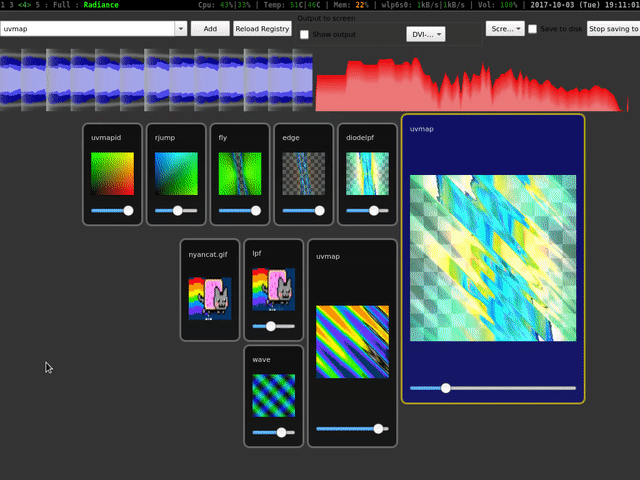Radiance is video art software for VJs. It supports beat detection, animated GIFs, YouTube video, OpenGL shader effects. It is designed for live performance and runs on Linux and MacOS.
Screencapture from this artwork
You can download Radiance for Linux or MacOS from the releases page.
Qt 5.9or higherPortAudioFFTW3libsamplerate
libmpvrtmidi
Install dependencies on Ubuntu:
$ sudo apt-add-repository ppa:beineri/opt-qt591-trusty
$ sudo apt-get update
$ sudo apt-get install qt59base qt59multimedia qt59quickcontrols qt59imageformats qt59quickcontrols2 qt59script libfftw3-dev libsamplerate0-dev libasound2-dev libmpv-dev libdrm-dev libgl1-mesa-dev
$ git clone https://github.com/EddieRingle/portaudio # build & install
$ git clone https://github.com/thestk/rtmidi # build & install
Note: you may need to install portaudio & rtmidi from git as above
git clone https://github.com/zbanks/radiance
git submodule update --init
cd radiance
mkdir build
cd build
cmake .. # -DCMAKE_PREFIX_PATH=/opt/qt59/ -DCMAKE_BUILD_TYPE=Debug
make
./radiance # Qt UI
./radiance_cli # Command line GIF generator
If you git pull changes, make sure you also do git submodule update to pull in changes to BTrack/.
Radiance uses libmpv to load videos, which can optionally use youtube-dl to stream videos from YouTube and many other sites. Since youtube-dl updates frequently, we have avoided bundling it with Radiance. Instead, on Linux:
sudo pip install youtube-dl
or on Mac:
brew install youtube-dl
You can then load YouTube videos into Radiance using the youtube node in the library.
Double click(in the library) - add tileClick(on a tile) - select tileCtrl-click(on a tile) - select multipleShift-click(on a tile) - select contiguousClick and drag(on a tile) - re-order selected tilesScroll wheel- change intensity of selected tilesCtrl-scroll wheel- zoom
:- Search libraryCtrl-+- Zoom inCtrl--- Zoom outCtrl-0- Reset zoom`,0-9- Set selected slider.`= 0%;1= 10%;5= 50%;0= 100%j- Decrement selected slider by 10%k- Increment selected slider by 10%Delete- Remove a tileCtrl+`,1-9- Assign slider to MIDI knobr- Reload tileEsc- Close output window
Radiance generates video from a set of connected "VideoNodes." Most commonly, these nodes are based on OpenGL fragment shaders, but can also be static images, GIFs, or videos. Each node takes one or more inputs and produces exactly one output.
Each OpenGL fragment shader node is described by a single .glsl file in resources/library/effects.
For the most part, these files are plain GLSL describing the fragment shader. This is similar to setups on shadertoy.com or glslsandbox.com . Each shader defines a function void main(void) which sets a pixel color vec4 fragColor for a given coordinate vec2 uv. fragColor is an RGBA color with pre-multiplied alpha: so white with 40% opacity is encoded as vec4(0.4, 0.4, 0.4, 0.4). The coodinate uv has x and y values in the range [0.0, 1.0] with vec2(0., 0.) corresponding to the lower-left corner.
The shader also has access to its input(s) as textures through the iInput (or iInputs[]) uniforms.
In addition, each shader has access to additional uniforms which are documented in resources/effects/*.glsl. The most important is iIntensity, which is a value in the range [0.0, 1.0] which is mapped to a slider in the UI that the user controls. There is a limitation of having exactly one input slider per effect: this is intentional to reduce the cognitive overhead on the end user. Other variables include information about the current audio or time.
Each shader must follow these properties:
- The
fragColorset by each shader must be a valid, pre-multiplied alpha, RGBA tuple. Each component of thevec4must be in the range[0.0, 1.0], and the RGB components must be less than or equal to the A component. (Seeafixhighlightfor a shader that will highlight errors here in pink) - Identity: the shader must pass through its first input completely unchanged when
iIntensity == 0.This means that inserting a new shader should not affect the output until its intensity is increased.
Some effects cannot be accomplished with a single fragment shader pass. An effect can consist of a series of shaders, separated by #buffershader. Each shader renders to a texture in iChannels[] (e.g. the first renders to iChannels[0]). The shaders are rendered in backwards-order, so the last shader in the file is rendered first. Only the output of the first shader in the file is displayed -- the other buffers persist between frames but are not exposed to other nodes.
An example that uses this feature is foh.glsl. This implements an (exponential) "first-order hold" - it samples the input texture on a multiple of the beat and stores it in iChannel[1].
Released under the MIT/X11 License. Copyright 2016 Zach Banks and Eric Van Albert.
